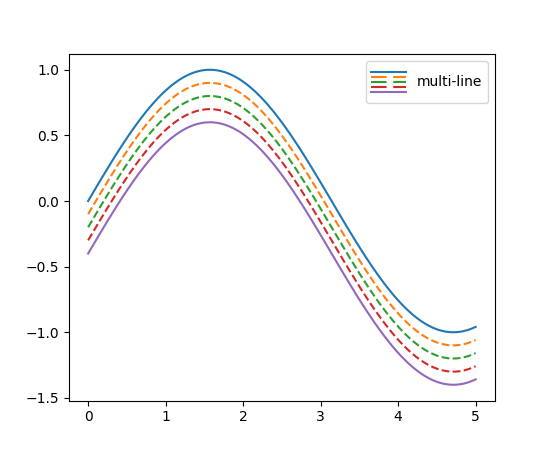
(Source code, png, pdf)

from __future__ import (absolute_import, division,
print_function, unicode_literals)
import six
from matplotlib import pyplot as plt
import numpy as np
from matplotlib.legend_handler import HandlerLineCollection
import matplotlib.collections as mcol
from matplotlib.lines import Line2D
class HandlerDashedLines(HandlerLineCollection):
"""
Custom Handler for LineCollection instances.
"""
def create_artists(self, legend, orig_handle,
xdescent, ydescent, width, height, fontsize, trans):
# figure out how many lines there are
numlines = len(orig_handle.get_segments())
xdata, xdata_marker = self.get_xdata(legend, xdescent, ydescent,
width, height, fontsize)
leglines = []
# divide the vertical space where the lines will go
# into equal parts based on the number of lines
ydata = ((height) / (numlines + 1)) * np.ones(xdata.shape, float)
# for each line, create the line at the proper location
# and set the dash pattern
for i in range(numlines):
legline = Line2D(xdata, ydata * (numlines - i) - ydescent)
self.update_prop(legline, orig_handle, legend)
# set color, dash pattern, and linewidth to that
# of the lines in linecollection
try:
color = orig_handle.get_colors()[i]
except IndexError:
color = orig_handle.get_colors()[0]
try:
dashes = orig_handle.get_dashes()[i]
except IndexError:
dashes = orig_handle.get_dashes()[0]
try:
lw = orig_handle.get_linewidths()[i]
except IndexError:
lw = orig_handle.get_linewidths()[0]
if dashes[0] is not None:
legline.set_dashes(dashes[1])
legline.set_color(color)
legline.set_transform(trans)
legline.set_linewidth(lw)
leglines.append(legline)
return leglines
x = np.linspace(0, 5, 100)
plt.figure()
colors = plt.rcParams['axes.prop_cycle'].by_key()['color'][:5]
styles = ['solid', 'dashed', 'dashed', 'dashed', 'solid']
lines = []
for i, color, style in zip(range(5), colors, styles):
plt.plot(x, np.sin(x) - .1 * i, c=color, ls=style)
# make proxy artists
# make list of one line -- doesn't matter what the coordinates are
line = [[(0, 0)]]
# set up the proxy artist
lc = mcol.LineCollection(5 * line, linestyles=styles, colors=colors)
# create the legend
plt.legend([lc], ['multi-line'], handler_map={type(lc): HandlerDashedLines()},
handlelength=2.5, handleheight=3)
plt.show()
Keywords: python, matplotlib, pylab, example, codex (see Search examples)